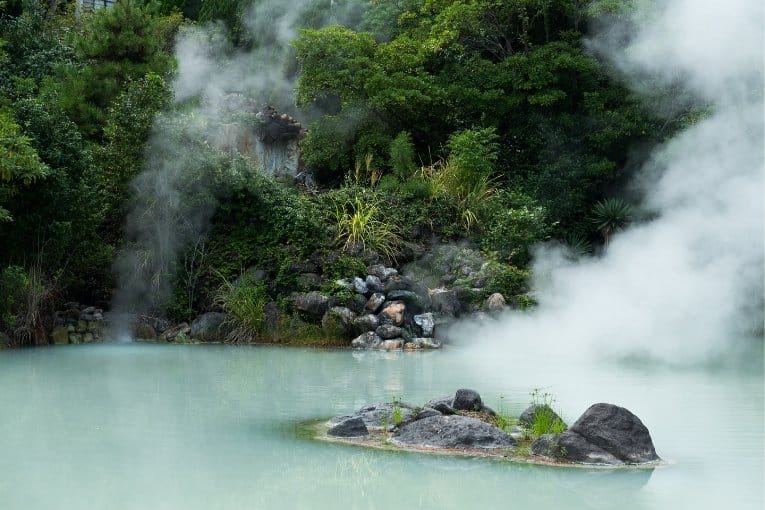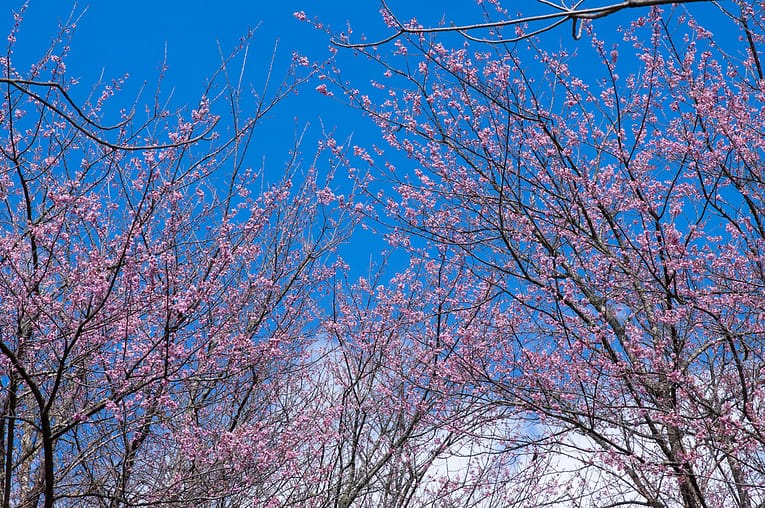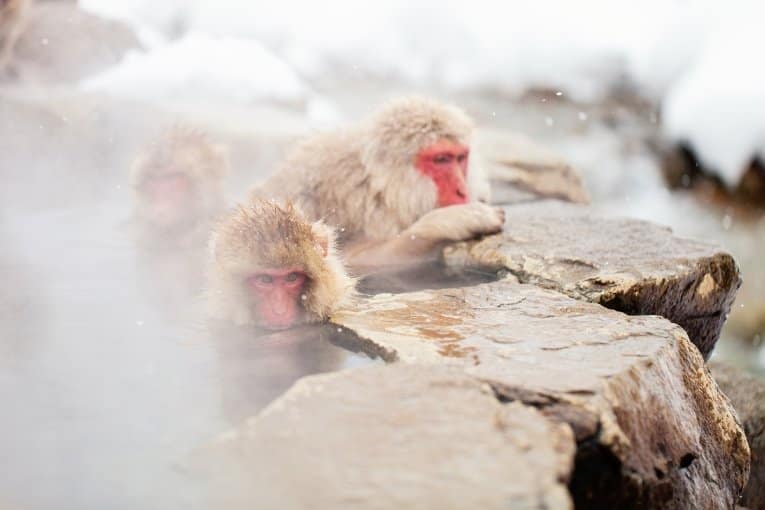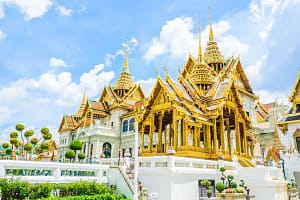Exploring Japan in February: A Guide to Things to Do in Japan in February
Japan in February is a land of breathtaking contrasts, where the serene beauty of winter landscapes collides with the vibrant pulse of cultural festivities. This is a time when the country, often cloaked in snow, offers a unique blend of activities that cater to both the adventurous spirit and the soul seeking tranquility. From the northern reaches of Hokkaido with its pristine snowscapes to the milder climates of the southern islands, February in Japan presents a tapestry of experiences that are as diverse as they are captivating.
The month is marked by a quieter, more introspective atmosphere than the hustle and bustle of Japan’s peak tourist seasons, making it an ideal time for those looking to explore the country’s natural beauty and cultural depth without the crowds. February also hosts some of Japan’s most iconic winter festivals, offering glimpses into the traditions and communal spirit that have shaped the nation’s cultural heritage. These festivals, set against the backdrop of Japan’s stunning winter scenery, provide unforgettable experiences that are both visually spectacular and deeply meaningful.
Beyond the festivals, February is an excellent month to indulge in winter sports, soak in steaming onsen (hot springs), and savor seasonal culinary delights that warm the body and soul. Whether you’re gliding down the powdery slopes of a ski resort, marveling at snow sculptures, or enjoying a hot pot dish in a cozy izakaya, February in Japan is a celebration of winter’s quiet beauty and the warmth of Japanese hospitality.
1. Attend the Sapporo Snow Festival

Photo Credit: y.ganden / Flickr
The Sapporo Snow Festival, held annually in February, transforms the city of Sapporo into a mesmerizing winter wonderland. Originating in 1950, this festival has grown from a small event with a few snow statues to a large-scale winter extravaganza, attracting over two million visitors from around the globe. The festival takes place across multiple sites, including Odori Park, Susukino, and Tsu Dome, each offering a unique experience.
- Trip Plan: Explore the Odori Park, Susukino, and Tsu Dome sites to see the sculptures and enjoy winter sports.
- Trip Budget: Mainly free to view sculptures; budget for food, drinks, and activities.
- Why Visit in February: Experience one of Japan’s most vibrant winter festivals, showcasing incredible artistry against the snowy backdrop of Hokkaido.
- Nearest Airports: New Chitose Airport.
- Transports to Use: Subway and buses in Sapporo for convenient access to festival sites.
- Tourist Attractions in February: Snow and ice sculptures, concerts, and local food stalls, along with unique events like the International Snow Sculpture Contest.
- Nearby Things to Do in Japan in February: Otaru, famous for its canal and the Otaru Snow Light Path Festival; also, Niseko for world-class skiing.
- Best Foods to Eat: Sapporo ramen, fresh seafood, and Hokkaido’s dairy products, including the famous soft serve ice cream.
- Best Places to Stay: Hotels in central Sapporo near Odori Park, ranging from luxury to budget options.
- Travel Tips: Dress warmly for the cold weather, including layers and waterproof shoes; book accommodations well in advance due to the festival’s popularity.
2. Visit the Otaru Snow Light Path Festival
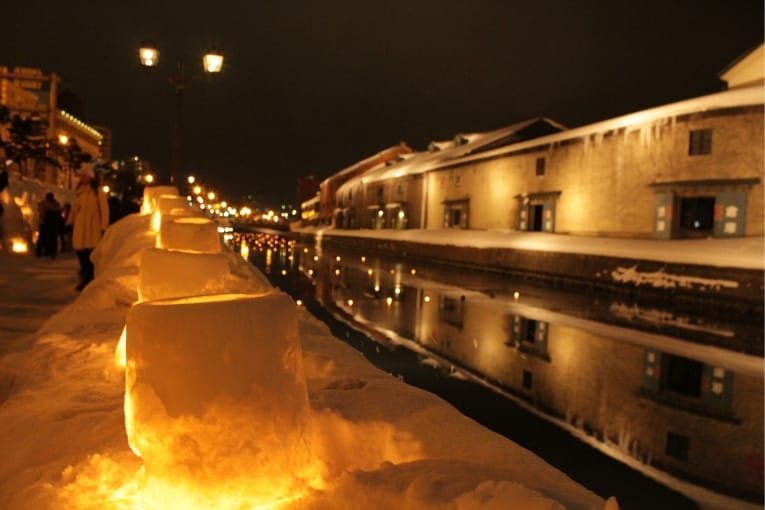
A romantic festival in Otaru, Hokkaido, where the city is illuminated by thousands of small lanterns and sculptures, creating a magical atmosphere.
- Trip Plan: Spend an evening walking through the city’s streets and canals, adorned with glittering lights and snow sculptures.
- Trip Budget: Free to explore; budget for dining and souvenirs.
- Why Visit in February: The festival creates a warm, enchanting environment in the cold winter, ideal for experiencing the charm of Otaru.
- Nearest Airports: New Chitose Airport.
- Transports to Use: Trains from Sapporo to Otaru; the city is walkable and perfect for exploring on foot.
- Tourist Attractions in February: Canal area and historical warehouses lit up, ice sculptures, and local performances.
- Nearby Things to Do in Japan in February: Sapporo, especially during the Snow Festival; Yoichi, known for its whisky distillery.
- Best Foods to Eat: Seafood, especially sushi and sashimi; Otaru’s famous sweets, like LeTAO cheesecake.
- Best Places to Stay: Boutique hotels and ryokan along the canal or in the city center.
- Travel Tips: Wear non-slip shoes for icy streets; visit during the evening for the best experience of the lights.
3. Hit the Ski Slopes
Enjoy some of the world’s best skiing and snowboarding conditions in areas like Niseko, Hakuba, and Nozawa Onsen.
- Trip Plan: Spend a few days at ski resorts like Niseko, Hakuba, or Nozawa Onsen, enjoying the slopes and après-ski activities.
- Trip Budget: Lift tickets and equipment rental can vary, approximately ¥5,000 to ¥7,000 per day; accommodation and meals extra.
- Why Visit in February: Consistent snowfall ensures excellent conditions for winter sports throughout the month.
- Nearest Airports: New Chitose Airport for Hokkaido resorts; Tokyo Haneda or Narita for the Japanese Alps.
- Transports to Use: Shuttle buses from airports to resorts; local buses and taxis within resort areas.
- Tourist Attractions in February: Besides skiing, enjoy snow festivals, hot springs, and local cuisine.
- Nearby Things to Do in Japan in February: Local onsens, traditional villages, and snow monkey parks near some resorts.
- Best Foods to Eat: Hearty dishes like ramen, curry, and hot pot, ideal for warming up after a day on the slopes.
- Best Places to Stay: Ski-in/ski-out resorts, onsen hotels, and local guesthouses.
- Travel Tips: Book ski equipment and lessons in advance; check resort websites for deals on lift tickets.
4. Warm Up in an Onsen
Japan’s hot springs, or onsens, offer a relaxing retreat from the cold, with many located in scenic areas.
- Trip Plan: Choose an onsen town like Noboribetsu, Hakone, or Beppu for a night or two of relaxation, including traditional ryokan stays.
- Trip Budget: Entry to public onsens is typically ¥500 to ¥2,000; ryokan stays vary greatly, from ¥10,000 to ¥50,000 per night with meals.
- Why Visit in February: The contrast of hot springs against the cold air and snowy landscapes is especially striking and soothing.
- Nearest Airports: Depends on the onsen location; New Chitose for Hokkaido, Tokyo airports for Hakone, and Oita for Beppu.
- Transports to Use: Trains and buses connect major cities to onsen towns; local transport or ryokan shuttles may be available.
- Tourist Attractions in February: Snowy landscapes, nearby temples and shrines, and traditional onsen town streets.
- Nearby Things to Do in Japan in February: National parks, scenic mountain areas, and local craft centers.
- Best Foods to Eat: Local specialties served at Ryokans, including multi-course kaiseki dinners.
- Best Places to Stay: Traditional ryokans offering the full Japanese onsen experience, including tatami rooms and onsen baths.
- Travel Tips: Bring a small towel for the onsen and understand onsen etiquette; book ryokans well in advance.
5. Experience Plum Blossoms
Witness the early bloom of plum blossoms, signaling the approach of spring, in various parks and gardens across Japan.
- Trip Plan: Visit renowned spots like Kairakuen Garden in Ibaraki and Dazaifu Tenmangu Shrine in Fukuoka to view the blossoms.
- Trip Budget: Entrance to most gardens and parks is free or requires a small fee, typically around ¥300 to ¥500.
- Why Visit in February: Plum blossoms offer a serene and less crowded alternative to the cherry blossom season, with equally stunning views.
- Nearest Airports: Tokyo Narita or Haneda for Kairakuen; Fukuoka Airport for Dazaifu Tenmangu.
- Transports to Use: Local trains and buses provide access to plum blossom viewing spots from nearby cities.
- Tourist Attractions in February: Plum blossom festivals often feature traditional performances, tea ceremonies, and local food stalls.
- Nearby Things to Do in Japan in February: Explore nearby temples, shrines, and traditional towns for a fuller cultural experience.
- Best Foods to Eat: Seasonal treats like umeboshi (pickled plum) and plum-flavored sweets; warm beverages like amazake.
- Best Places to Stay: Local hotels and ryokans in the cities near the viewing spots offer convenient access and traditional lodging options.
- Travel Tips: Check bloom forecasts before your visit for the best timing; early mornings or weekdays are less crowded.
6. Discover Historic Castles
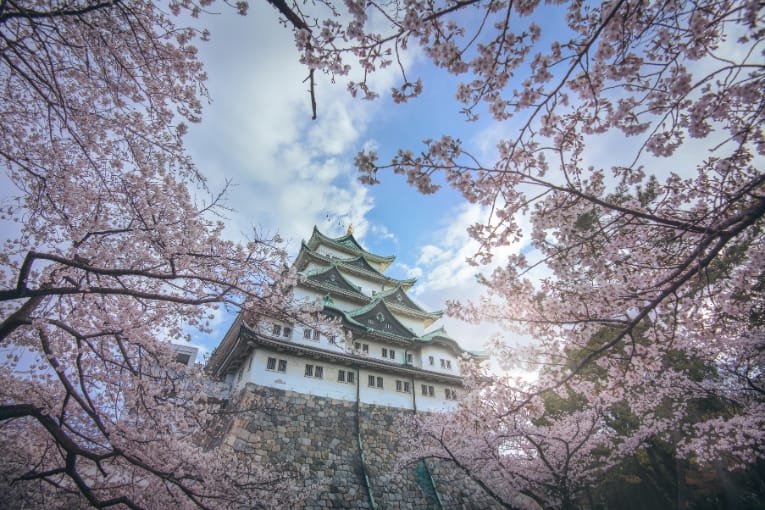
Explore Japan’s majestic castles, many of which are beautifully preserved and offer a glimpse into the country’s feudal past.
- Trip Plan: Include visits to famous castles like Himeji Castle, a UNESCO World Heritage Site, or the snow-covered Matsumoto Castle.
- Trip Budget: Entrance fees for castles range from ¥600 to ¥1,000; additional costs for guides or special exhibitions may apply.
- Why Visit in February: The contrast of historic castles against the backdrop of snow or clear winter skies is particularly striking.
- Nearest Airports: Kansai International Airport for Himeji; Tokyo Narita or Haneda for Matsumoto.
- Transports to Use: Shinkansen (bullet trains) and local trains connect major cities to castle towns; local buses or walking for city exploration.
- Tourist Attractions in February: Castle parks and gardens, often with winter illuminations or events.
- Nearby Things to Do in Japan in February: Nearby traditional towns, such as Takayama near Matsumoto, offer additional cultural experiences.
- Best Foods to Eat: Local specialties in castle towns, such as Kobe beef near Himeji or soba noodles in Matsumoto.
- Best Places to Stay: City hotels or traditional ryokans near the castles provide easy access and local charm.
- Travel Tips: Wear comfortable shoes for exploring castle grounds and stairs; check for any renovation work that might restrict access to parts of the castles.
7. Savor Hokkaido’s Seafood

Hokkaido is renowned for its fresh, high-quality seafood, including crab, scallops, and sea urchin, offering a culinary delight.
- Trip Plan: Visit seafood markets like Sapporo’s Nijo Market or Hakodate’s Morning Market to taste fresh catches and local dishes.
- Trip Budget: Costs vary widely; budget ¥2,000 to ¥10,000 for a seafood meal, depending on the type of seafood and dining establishment.
- Why Visit in February: Seafood is particularly rich and flavorful during the cold winter months, with crab and oysters at their peak.
- Nearest Airports: New Chitose Airport for Sapporo; Hakodate Airport for Hakodate.
- Transports to Use: City subways and trams in Sapporo and Hakodate; walking is often feasible for market visits.
- Tourist Attractions in February: Ice fishing festivals and seafood-related events add to the culinary experience.
- Nearby Things to Do in Japan in February: Nearby onsen towns like Noboribetsu offer a perfect end to a day with a seafood feast.
- Best Foods to Eat: Don’t miss trying king crab, fresh sashimi, sea urchin, and grilled scallops.
- Best Places to Stay: Hotels and ryokans in Sapporo or Hakodate provide easy access to seafood markets and dining areas.
- Travel Tips: Visit markets early in the morning for the freshest selection; some stalls offer tastings or small dishes to sample a variety of seafood.
8. Attend a Traditional Tea Ceremony
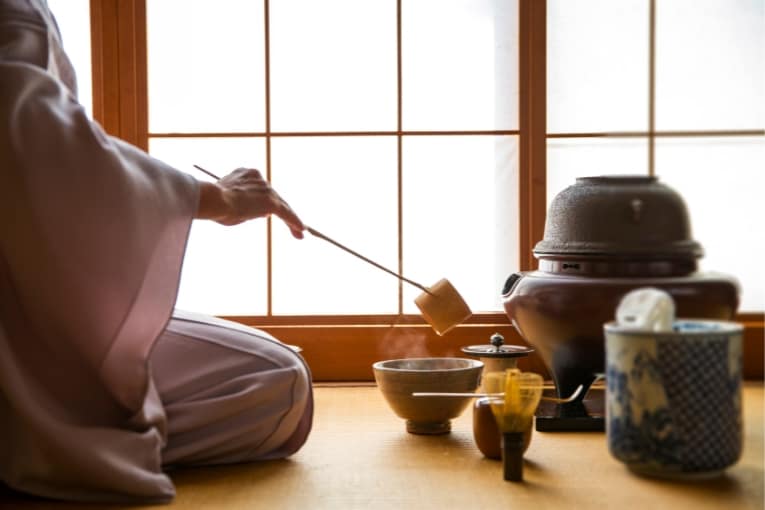
Experience the serene and ritualistic art of the Japanese tea ceremony, a cultural activity that embodies the principles of harmony, respect, purity, and tranquility.
- Trip Plan: Participate in a tea ceremony at historical tea houses or cultural centers in cities like Kyoto or Tokyo.
- Trip Budget: Prices for attending a tea ceremony range from ¥2,000 to ¥5,000 per person, depending on the venue and the length of the ceremony.
- Why Visit in February: The quiet calm of February adds to the contemplative atmosphere of the tea ceremony, making it a perfect indoor activity during the cold weather.
- Nearest Airports: Tokyo Haneda or Narita for Tokyo; Kansai International Airport for Kyoto.
- Transports to Use: Local trains and subways provide convenient access to tea ceremony venues in urban centers.
- Tourist Attractions in February: Many tea houses are located near major temples and shrines, which are also peaceful to explore in February.
- Nearby Things to Do in Japan in February: Explore the historical districts where tea ceremonies are held, such as Gion in Kyoto or Asakusa in Tokyo.
- Best Foods to Eat: Traditional Japanese sweets (wagashi) are often served during the ceremony, complementing the bitterness of matcha tea.
- Best Places to Stay: Stay in traditional ryokans or hotels in the area for a full cultural immersion.
- Travel Tips: Be sure to familiarize yourself with basic tea ceremony etiquette before attending, such as how to properly receive and drink the tea.
9. Visit the Snow Monkeys
See the famous Japanese macaques (snow monkeys) that enjoy soaking in the natural hot springs in the Jigokudani Monkey Park in Nagano.
- Trip Plan: Spend a day visiting the park, ideally combined with exploring the surrounding Nagano area.
- Trip Budget: Entrance to the park is about ¥800 for adults; factor in transportation and meals.
- Why Visit in February: The snow monkeys are particularly picturesque against the snowy backdrop, and February’s cold weather ensures they are frequently found in the onsen.
- Nearest Airports: Tokyo Narita or Haneda, followed by a train journey to Nagano.
- Transports to Use: Shinkansen (bullet train) to Nagano, then local buses or rental car to Jigokudani Monkey Park.
- Tourist Attractions in February: Besides the monkey park, Nagano is famous for its ski resorts and beautiful winter landscapes.
- Nearby Things to Do in Japan in February: Visit Zenkoji Temple in Nagano or take a trip to the nearby ski resorts like Hakuba.
- Best Foods to Eat: Warm up with Nagano specialties such as soba noodles and oyaki (stuffed dumplings).
- Best Places to Stay: Stay in Nagano city or local ryokans near the monkey park for easy access.
- Travel Tips: Wear sturdy, waterproof boots for the trek to the park, and dress warmly in layers.
10. Explore Kyoto’s Temples and Shrines
Kyoto, Japan’s ancient capital, is home to over a thousand temples and shrines, offering a window into the country’s rich history and spiritual heritage.
- Trip Plan: Dedicate several days to explore famous sites like Kinkaku-ji (the Golden Pavilion), Fushimi Inari Taisha, and Kiyomizu-dera.
- Trip Budget: Many temples and shrines have free entry, though some charge an entrance fee of ¥300 to ¥600.
- Why Visit in February: The crowds are smaller, and the temples and shrines are often enhanced by the serene beauty of winter, possibly with light snowfall.
- Nearest Airports: Kansai International Airport.
- Transports to Use: Kyoto’s efficient bus system, along with trains and subways, offers easy access to most historic sites.
- Tourist Attractions in February: Winter illuminations at certain temples, and Setsubun festivals (early February) marking the start of spring according to the lunar calendar.
- Nearby Things to Do in Japan in February: Nara, another historic city with famous temples and the Nara Deer Park is a short train ride away.
- Best Foods to Eat: Kyoto cuisine, known for its refined flavors, includes kaiseki dining, tofu specialties, and matcha-based sweets.
- Best Places to Stay: Traditional ryokans in Gion or central Kyoto for easy access to historic sites and a full cultural experience.
- Travel Tips: Many temples close early in the winter months, so plan to start your day early to maximize your visits.
11. Participate in Setsubun Festivals
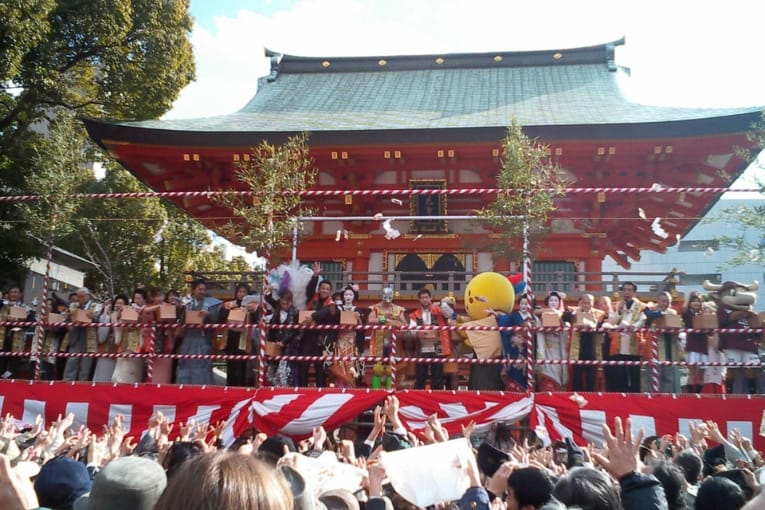
Photo Credit: Archie02 / Wikipedia
Setsubun, marking the beginning of spring according to the Japanese lunar calendar, is celebrated with bean-throwing festivals to drive away evil spirits and bring good fortune.
- Trip Plan: Attend Setsubun ceremonies at major temples and shrines across Japan, such as at Senso-ji in Tokyo or Yasaka Shrine in Kyoto.
- Trip Budget: Participating in Setsubun events is generally free, though you may wish to budget for special Setsubun beans and other festive items.
- Why Visit in February: Experience a unique aspect of Japanese culture and tradition not seen at other times of the year.
- Nearest Airports: Tokyo Haneda or Narita for Tokyo; Kansai International Airport for Kyoto.
- Transports to Use: Local trains and buses to reach temples and shrines hosting Setsubun events.
- Tourist Attractions in February: In addition to Setsubun, enjoy the quiet beauty of Japan’s gardens and temples in winter.
- Nearby Things to Do in Japan in February: Explore the historical areas surrounding the temples and shrines, offering insights into Japanese history and culture.
- Best Foods to Eat: Try eho-maki, special sushi rolls eaten on Setsubun for good luck, facing the year’s lucky direction.
- Best Places to Stay: Choose accommodations close to major cultural sites for easy access to Setsubun festivals.
- Travel Tips: Learn the proper way to throw beans during the festival to fully participate in the tradition.
12. Go Ice Fishing
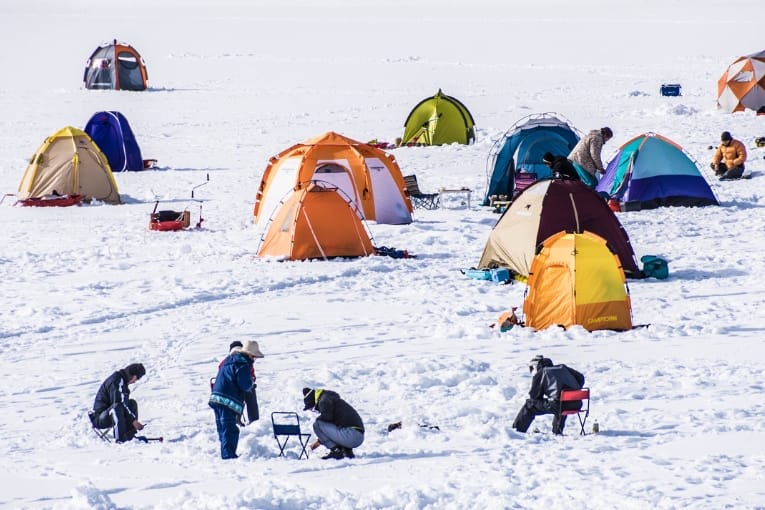
Photo Credit: Petra Bensted / Flickr
Ice fishing, particularly for wakasagi (smelt), is a popular winter activity on frozen lakes in Hokkaido and other parts of Japan.
- Trip Plan: Spend a day ice fishing at locations like Lake Akan or Lake Shikaribetsu, often with the option to cook and eat your catch on the spot.
- Trip Budget: Rental equipment and fishing tours range from ¥2,000 to ¥5,000, including gear and sometimes a heated tent.
- Why Visit in February: Lakes are fully frozen, ensuring the best conditions for ice fishing amidst beautiful winter landscapes.
- Nearest Airports: New Chitose Airport for Hokkaido locations.
- Transports to Use: Rental cars or tour buses are often the best way to reach more remote ice fishing spots.
- Tourist Attractions in February: Many ice fishing locations are near winter festivals and onsen towns, adding to the experience.
- Nearby Things to Do in Japan in February: Combine your trip with visits to nearby onsen resorts for a perfect end to a cold day outdoors.
- Best Foods to Eat: Freshly caught and grilled wakasagi is a must-try, along with local Hokkaido specialties like soup curry and seafood.
- Best Places to Stay: Stay in nearby towns or onsen resorts to enjoy warm hospitality after a day on the ice.
- Travel Tips: Dress in warm, waterproof clothing and check weather conditions and ice safety with local guides before heading out.
13. Explore Illumination Events
Winter illuminations light up cities across Japan, turning parks, gardens, and cityscapes into dazzling nighttime wonderlands.
- Trip Plan: Visit famous illumination spots like Nabana no Sato in Mie Prefecture or the Tokyo Dome City Winter Illumination.
- Trip Budget: Many illumination events are free, though some locations may charge an entrance fee, typically around ¥1,000 to ¥3,000.
- Why Visit in February: The illuminations create a magical atmosphere, offering a warm glow against the cold winter nights.
- Nearest Airports: Chubu Centrair International Airport for Mie Prefecture; Tokyo Haneda or Narita for Tokyo.
- Transports to Use: Local trains, subways, and buses provide access to most illumination events in urban and suburban areas.
- Tourist Attractions in February: Beyond the lights, enjoy seasonal markets, hot drinks, and festive treats at many illumination sites.
- Nearby Things to Do in Japan in February: Many illumination events are held in or near major tourist attractions, offering a chance to explore the area by day and the lights by night.
- Best Foods to Eat: Street food stalls at illumination events offer seasonal snacks like roasted chestnuts, hot cocoa, and amazake.
- Best Places to Stay: Choose accommodations near the illumination events for easy evening access and to enjoy the city’s night views.
- Travel Tips: Weekends can be crowded; consider visiting on a weekday for a more relaxed experience.
14. Experience the Hadaka Matsuri (Naked Festival)
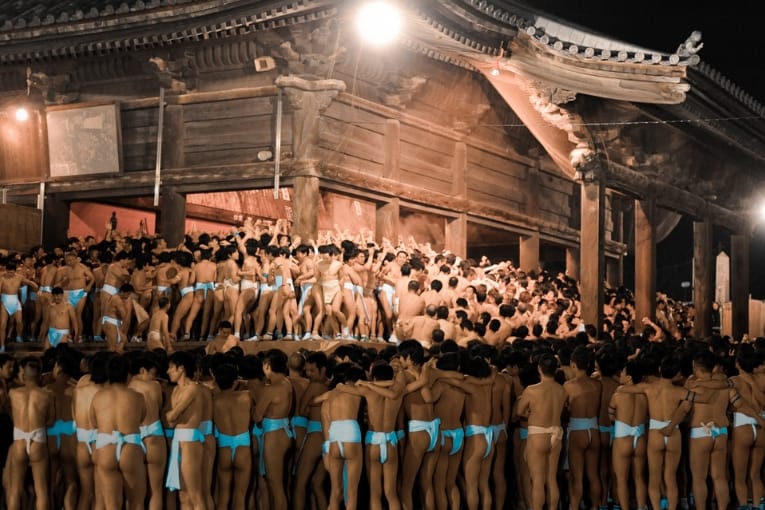
Photo Credit: Mstyslav Chernov / Wikipedia
The Hadaka Matsuri, or Naked Festival, is a traditional Japanese festival held in Okayama, where thousands of men wearing only loincloths compete to grab a pair of lucky sacred sticks.
- Trip Plan: Witness this ancient festival, which takes place at Saidai-ji Temple, typically on the third Saturday of February.
- Trip Budget: Viewing the festival is free, but budget for transportation and food.
- Why Visit in February: This unique cultural event offers insight into Japan’s traditional rites and the local community’s spirit.
- Nearest Airports: Okayama Airport.
- Transports to Use: Trains and buses are available from Okayama Station to Saidai-ji Temple.
- Tourist Attractions in February: Explore Okayama Castle and Korakuen Garden, one of Japan’s three great gardens, while in the area.
- Nearby Things to Do in Japan in February: Visit Kurashiki, known for its historic Bikan district with beautiful canals and traditional buildings.
- Best Foods to Eat: Sample local specialties such as Okayama’s famous fruit, particularly peaches, and kibi dango (millet dumplings).
- Best Places to Stay: Hotels and ryokans in Okayama city offer easy access to the festival and other attractions.
- Travel Tips: Dress warmly, as February nights can be very cold, especially if you plan to stay outdoors to watch the festival.
15. Visit the Asahikawa Winter Festival
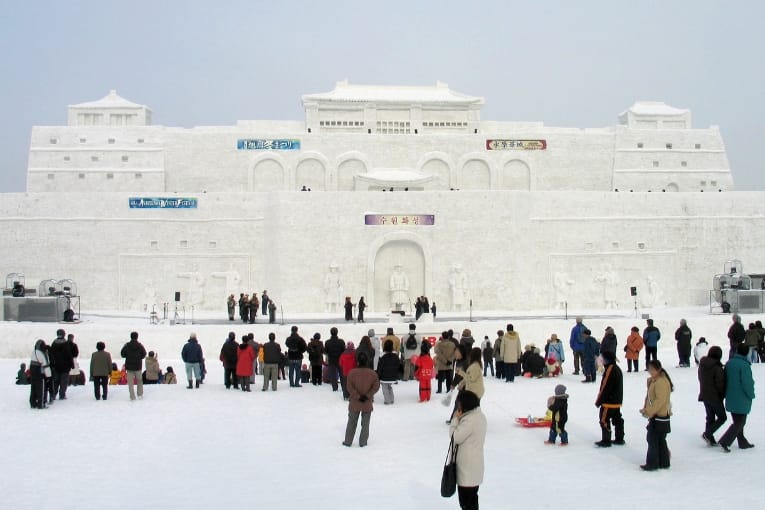
Photo Credit: 京浜にけ / Wikipedia
Held in Asahikawa, Hokkaido, this winter festival is famous for its large snow sculptures, ice bar, and activities like snow rafting and snowmobiling.
- Trip Plan: Allocate a day or two to experience the festival’s sculptures, performances, and winter activities.
- Trip Budget: Festival entry is free, but activities and food at the festival site may incur costs.
- Why Visit in February: The festival showcases spectacular snow art and offers fun winter activities suitable for all ages.
- Nearest Airports: Asahikawa Airport.
- Transports to Use: Buses and taxis from the Asahikawa city center provide easy access to the festival site.
- Tourist Attractions in February: The Asahiyama Zoo’s winter penguin walk is a popular nearby attraction.
- Nearby Things to Do in Japan in February: Visit the nearby Daisetsuzan National Park for stunning winter landscapes and onsen experiences.
- Best Foods to Eat: Try Hokkaido specialties like ramen, fresh seafood, and dairy products at the festival food stalls.
- Best Places to Stay: Hotels in Asahikawa City offer convenient access to the festival and are close to restaurants and shops.
- Travel Tips: Dress in warm, waterproof clothing for outdoor festival activities, and book accommodations early due to the festival’s popularity.
Conclusion: Embracing Japan’s Winter Magic in February
As the chill of February settles over Japan, the country transforms into a mosaic of cultural festivities, natural beauty, and culinary excellence. The unique blend of activities available during this month offers travelers an unparalleled opportunity to delve into Japan’s rich traditions and vibrant contemporary culture. From the serene beauty of plum blossoms heralding the approach of spring to the exhilarating atmosphere of snow festivals, each event and activity is a testament to the country’s deep appreciation for the seasons and its commitment to preserving and celebrating its heritage.
The experiences range from the adrenaline-fueled excitement of skiing on world-renowned slopes to the tranquil moments spent in a steaming onsen, set against a backdrop of snow-covered landscapes. These moments not only provide warmth and relaxation but also a deep connection to the natural world that is so revered in Japanese culture. Meanwhile, the culinary adventures, from street food at bustling winter markets to exquisite kaiseki meals in a ryokan, highlight the seasonal and regional diversity of Japan’s cuisine, offering flavors and experiences that are as varied as they are delicious.
In essence, visiting Japan in February is to witness a country brimming with contrast and harmony: modernity and tradition, celebration and contemplation, cold and warmth. It’s a journey through a winter wonderland that invites exploration and reflection, offering each traveler a unique story to tell. Whether it’s marveling at the delicate beauty of a plum blossom, participating in ancient festivals, or simply enjoying the crisp winter air, February in Japan is a time of enchantment, inviting all who visit to embrace the magic of the season.


